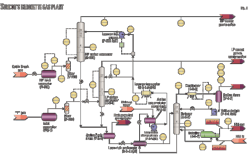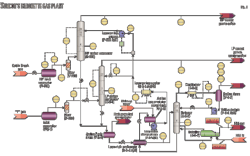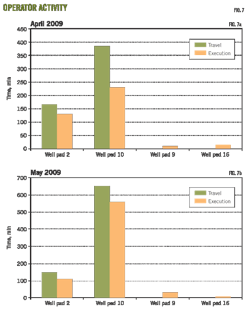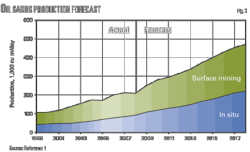SPECIAL REPORT: Explorers directing efforts at frontier, underexplored, nonproducing basins
Alan Petzet
Chief Editor-Exploration
OGJ's annual Exploration & Development Frontiers special highlights random areas of the world in which companies are searching for oil and gas in underexplored or nonproducing basins.
There is nothing quite like the price of crude oil floating around $100/bbl to make explorers turn to their favorite use of those funds: replacing depleting reserves. Nevertheless, many of these higher-risk activities were proceeding before prices neared the century mark.
These areas are important from a geoscience perspective but do not necessarily receive the degree of notoriety as, for example, the discoveries off Brazil and Ghana.
This article describes exploratory action in the deepwater Rovuma basin off Mozambique, the South Kara Sea basin in the Russian Arctic, the Iquitos arch of the Maranon basin in northeastern Peru, the Utsira high in the North Sea on the Norwegian Continental Shelf, the Laurentian basin in the Gulf of St. Lawrence off Newfoundland and Quebec, and the Guyana-Suriname basin off French Guiana.
Rovuma basin off Mozambique
Four large gas discoveries in 2010 and early 2011 have opened potential in the deepwater part of the Rovuma basin off Mozambique.
Operator Anadarko Petroleum Corp. assigned a team to tackle conceptual work for a liquefied natural gas project tagged Labarquenjammer, a composite of the names of three of the discoveries the company said has the potential to become a megaproject. A resource of more than 4 tcf supports the project with much exploration potential remaining.
The company made clear that the Bedford Dolphin drillship will keep working on the 2.6 million acre Offshore Area 1 in the Mozambique Channel for the foreseeable future and that it might add a second rig in late 2011.
The 2011 plan calls for drilling more exploratory prospects on the northern part of the block, appraising the four discoveries, and cutting a bypass core in the 26-mile gap between the Windjammer and Tubarao discoveries.
The Anadarko group in February was shooting 3D seismic south of its existing 3D survey and afterward was to shoot 3D north of existing data, giving it full 3D coverage of the deepwater part of the block by midyear.
The southern 3D survey will also give the company a better look at the oil potential around its Ironclad discovery, the first documented occurrence of liquid hydrocarbons in deep water off East Africa.
Ironclad-1 near the southern edge of existing 3D coverage, went to 5,304 m and penetrated 205 m of targeted Cretaceous-age sediments in an areally extensive deepwater fan complex, the upper lobe of which had 38 m of net oil and gas-saturated sands, partner Cove Energy PLC said.
The early gas discoveries, which have exposed at least eight play styles:
• Tubarao, 110 net ft of gas pay without water in a high-quality Eocene-age reservoir in a new play style. TD 13,900 ft in 2,950 ft of water 18 miles offshore and 26 miles southwest of Lagosta (see map, OGJ, May 17, 2010, p. 35). Seismic indicates 15,000-acre areal extent.
• Lagosta, more than 550 net ft of gas pay in multiple, high-quality sands of Oligocene and Eocene age. TD is 15,900 ft in 5,080 ft of water 16 miles south of Barquentine.
• Barquentine, 308 net ft of gas pay in multiple high-quality Oligocene sands distinct from but age equivalent to those at Windjammer plus 108 ft of gas pay in Paleocene sands similar to those at Windjammer 2 miles southwest. TD 16,880 ft in 5,200 ft of water.
• Windjammer, more than 480 net ft of gas pay in high-quality reservoir sands in a gross column more than 1,200 ft thick above 14,000 ft and a further 76 ft of gas pay in Paleocene sands. TD 16,930 ft in 4,800 ft of water 30 miles offshore.
Offshore Area 1 interests are Anadarko 36.5%, Mitsui E&P Mozambique Area 1 Ltd. 20%, BPRL Ventures Mozambique BV 10%, Videocon Mozambique Rovuma 1 Ltd. 10%, and Cove Energy Mozambique Rovuma Offshore Ltd. 8.5%. Empresa Nacional de Hidrocarbonetos EP's 15% interest is carried through the exploration phase.
South Kara Sea basin, Russian Arctic offshore
An arbitration tribunal in late March blocked a planned strategic global alliance between OAO Rosneft of Russia and BP PLC that would have included an Arctic offshore exploration joint venture in the Kara Sea among other elements.
Rosneft and BP maintained they are still committed to the alliance even though BP's partners in TNK-BP claimed the exclusive right to pursue new ventures for BP in Russia.
The original January 2011 agreement called for Rosneft and BP to form a $7.8 billlion alliance that included a stock swap, an Arctic offshore exploration joint venture and research effort, and a refining partnership.
The companies agreed to explore and develop the EPNZ 1, 2, and 3 blocks in the underexplored South Kara Sea basin in relatively shallow water on the Russian Arctic continental shelf (Fig. 1).
These licenses were awarded to Rosneft in 2010 and cover 125,000 sq km in a highly prospective area of the South Kara Sea. The area is similar in size and prospectivity to the UK North Sea.
Between EPNZ-3 and the Yamal Peninsula lies Rusanovskoye, a supergiant gas field in an area navigable only 2-3 months/year without the aid of icebreakers.
Undeveloped Rusanovskoye, discovered in 1989 in 50 m of water, could hold as much as 282.4 tcf of recoverable gas (see map, OGJ, Aug. 6, 1990, pp. 28-29).
Exploration plans during the Soviet era called for tests of at least nine other structures in the Kara Sea's southwest arm, and two other giant and possibly supergiant central Yamal Peninsula fields were known to have major extensions beneath the Kara Sea.
BP and Rosneft also agreed to establish an Arctic technology center in Russia that will work with leading Russian and international research institutes, design bureaus, and universities to develop technologies and engineering practices for the safe extraction of hydrocarbon resources from the Arctic shelf. The technology center will build on BP's deep offshore experience and learnings with full emphasis on safety, environmental integrity, and emergency spill response capability.
Rosneft and BP will continue their joint technical studies in the Russian Arctic to assess hydrocarbon prospectivity in areas beyond the Kara Sea. A presentation slide called attention to the greater Sakhalin Island area Russia's entire Arctic shelf from Yamal-Kara to the Russian Far East.
The Kara Sea covers 341,000 sq miles; water depth averages 120 m and extends at least as deep as 200 m.
However, just east of Novaya Zemlya lies the huge Novaya Zemlya trough, with water more than 500 m deep in some places. The trough extends nearly the full length of the 500-mile long Novaya Zemlya Island, part of the boundary between the Kara Sea and Barents Sea basins. The Rosneft-BP blocks lie generally east of the trough.
In the Barents Sea some 200 miles west of the Kara Sea lies supergiant Shtokmanovskoye gas-condensate field, discovered in 1988 in 200-300 m of water. Shtokmanovskoye, 350 miles northeast of Murmansk with an estimated 137 tcf of recoverable gas, is in an early phase of development by a unit of Gazprom JSC for an LNG project (OGJ Online, Nov. 29, 2010).
Iquitos arch, northeastern Peru
Gran Tierra Energy Inc., Calgary, expressed some astonishment at what it uncovered in March 2011 as it declared the Kanatari-1 exploratory well on Peru's Iquitos arch a dry hole.
Gran Tierra said, "We are disappointed with the lack of hydrocarbon shows in the Kanatari-1 frontier exploration well but are intrigued by the presence of a spectacular reservoir-quality sandstone section capped by a thick sealing shale section.
"New 2D seismic data indicate the sandstone section pinches out updip on the Iquitos arch in a trapping position with considerable upside potential. With this new data, we will continue to evaluate the prospectivity of the large, unexplored acreage position we have established in this portion of Peru."
Gran Tierra has 100% working interest in Kanatari-1 on the 2.3 million acre Block 128.
The frontier exploration well is located on the eastern flank of the Maranon basin 130 km east of the nearest well in Peru. It went to a total depth of 3,395 ft measured depth.
The well encountered a sandstone reservoir sequence 932 ft thick overlying basement, which was encountered at 3,247 ft MD. Total net reservoir of 692 ft with average porosity of 25% was interpreted from wireline logs acquired after drilling. The reservoir section was overlain by 256 ft of sealing shale sequence.
No oil or gas shows were noted during drilling and interpretations from wireline logs indicate the reservoirs are water bearing.
Gran Tierra pointed out that Kanatari-1 confirmed the presence of two key components of a petroleum system on Block 128, the presence of reservoir and seal, with petroleum migration and trapping remaining unproven.
Interpretation of the well data and integration with recent 2D seismic data acquired on Block 128 indicate a potential stratigraphic pinchout play analogous to those trapping hydrocarbons in the Orinoco Belt of Venezuela exists updip from the Kanatari location. This potential will be the focus of Gran Tierra's ongoing evaluations.
Future drilling in Block 122 will depend on the integration of the well results to the new 2D seismic data and regional geologic model, the company said.
Gran Tierra in late 2010 agreed to acquire, subject to government approvals, a 20% working interest in blocks 123, 124, and 129 operated by ConocoPhillips subsidiary Burlington Resources Peru Ltd., Sucursal Peruana, on the flank of the Iquitos arch.
Those three blocks cover 6.7 million acres contiguous to blocks 122 and 128.
Utsira high, Norwegian Continental Shelf
Underexplored parts of mature basins have yielded important discoveries in 2010.
Lundin Petroleum AB, Stockholm, was to decide by the end of the first quarter of 2011 on either standalone or joint development options for the 2007 Luno and 2009 Draupne oil fields on the Utsira high in the Central North Sea off Norway.
The Swedish operator has had the fortune of several discoveries in what is known as the Greater Luno area and hasn't fully explored the area yet (Fig. 2).
Luno was a 2007 discovery in PL338 and has been appraised by two wells that boosted proved and probable reserves to 148 million bbl of oil equivalent from 95 million boe. Draupne is in PL001B.
In September 2010 a Lundin group made the Avaldsnes discovery 25 km east of Luno in Block 16/2, part of PL501, for which it estimated a recoverable 100-400 million bbl of oil equivalent. Lundin's predrill estimate was 130 million boe.
The Avaldsnes well cut a 17-m oil column in a Jurassic sandstone. TD is 2,132 m measured depth.
Then in December 2010 came the Apollo discovery in PL338 about 5 km from Luno with an estimated 15-65 million boe recoverable in Paleocene and Cretaceous reservoirs. Apollo is to be appraised in 2012 and probably developed through Luno.
The Avaldsnes discovery well flowed at a restricted 5,000 b/d of oil, and Lundin estimated that the structure extends to the west into PL265, in which the company has 10% working interest.
In the 2011 first half, Lundin plans two Avaldsnes appraisal wells in PL501, and Statoil, PL265 operator, is to drill another well on the structure. The element of Avaldsnes in PL265 has been named Aldous Major South.
The Avaldsnes discovery has successfully proven the migration of hydrocarbons to the eastern side of the Utsira high.
More exploratory wells are planned in the Greater Luno area. The Tellus prospect in PL338, on which Lundin has 50% working interest, was drilling early in the year. Aldous Major North, formerly Torvestad, in PL265/PL501, will be followed by likely wells in 2012 on PL359, Lundin 40%, and PL410, 70%.
Laurentian basin, Newfoundland-Quebec, Canada
Corridor Resources Inc., Halifax, NS, filed a project description in February 2011 for the drilling of an exploratory well on the Old Harry prospect in Atlantic Canada's Laurentian Channel (Fig. 3).
The filing started the official regulatory process to obtain approvals to drill the offshore well between mid-2012 and early 2014.
The surface location is in 1,400 ft of water in the Gulf of St. Lawrence off Newfoundland on Exploration License 1105, and the prospect lies beneath Newfoundland and Quebec waters (Fig. 3). The filing is in the hands of the Canada-Newfoundland and Labrador Offshore Petroleum Board.
Old Harry, on the northern margin of the Carboniferous Magdalen basin, is on trend with porous, permeable, oil-stained Westphalian "B" sands tested (water bearing) by the Texaco Brion Island well drilled in 1970. The prospective sands lie at a relatively shallow drilling depth of 4,000-6,000 ft (OGJ, Sept. 28, 1998, p. 107).
Old Harry at 30 km long and 12 km wide is one of the largest undrilled structures in eastern Canada. It could hold at least 1.5 billion bbl of oil or 4-5 tcf of gas recoverable, Corridor indicated.
The company previously completed an extensive work program to identify the proposed well location on the western side of EL 1105, which included the collection and interpretation of 2D seismic data in 1998 and 2002 and a geohazard site survey in October 2010 (OGJ Online, Oct. 1, 2010).
Only 10 offshore wells have been drilled in the gulf.
Guyana-Suriname basin, French Guiana
Tullow Oil PLC spudded the GM-ES-1 exploratory well Mar. 4 on the Guyane Maritime permit off French Guiana, one day after authorities gave the green light.
The Ensco 8503 semisubmersible is drilling the well in 1,000 m of water. Drilling time is estimated at 90 days.
Tullow, which shot 3D seismic between September 2009 and the end of February 2010, estimated that the permit 150 km off Cayenne could hold 40 million to 1 billion bbl of oil. The well is given a 10% chance of finding 700 million bbl of oil.
Tullow said interpretation of the data in 2010 "confirmed the presence of the major Late Cretaceous turbidite system previously identified on the existing regional 2D seismic in 2008. A portfolio of high risk but high impact deepwater prospects analogous to the Jubilee field in Ghana have been interpreted.
"The well has the potential to open up a major new oil province in French Guiana with a significant number of further prospects and leads already identified."
Tullow Oil has 27.5% interest in partnership with Shell France 45%, Total 25%, and Northpet Investments Ltd. 2.5%. Northern Petroleum PLC and Wessex Exploration PLC each own 50% equity interest in Northpet.
Northern said the projected total depth is 6,500 m subsea at a spot 50 km from the international boundary with Brazil.
More Oil & Gas Journal Current Issue Articles
More Oil & Gas Journal Archives Issue Articles
View Oil and Gas Articles on PennEnergy.com



